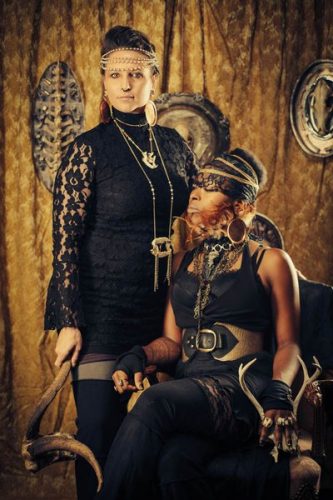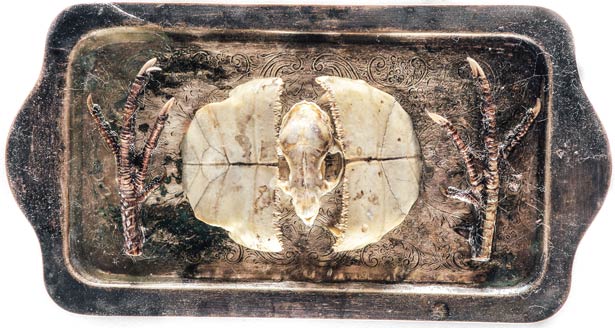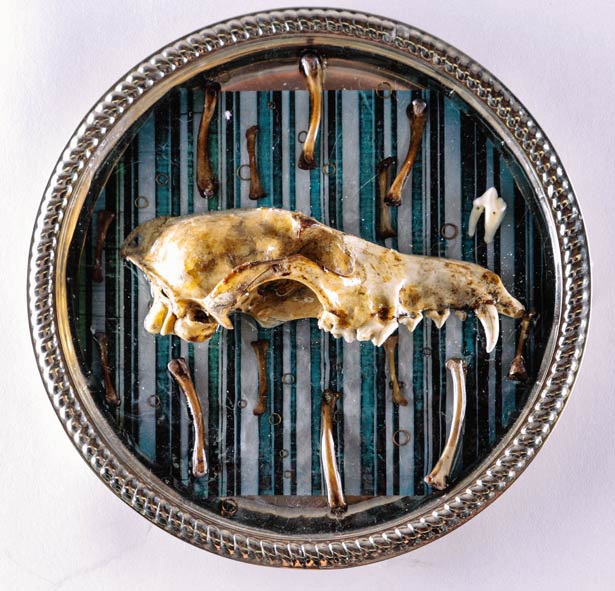
Wander roads anywhere and chances are you’ll spot animal bones strewn in ditches, a feather on the ground, snake skins baked onto asphalt, even a plump frog that defied a crow’s keen senses. Maybe you’ll feel lucky to find an intact, desiccated owl carcass you just can’t leave behind. Unlike beer bottles, soda cans and other litter that careless people toss out of vehicle windows, under most circumstances it’s actually illegal to take any part of a dead animal home.
There are an unknown number of us who are unafraid to handle a lifeless body. Some of us feel compelled to remove the dead animals lying ravaged along roadways out of respect for the animal, to offer the animal a more dignified end than to be pummeled to dust by a succession of steel-belted radials.
Other folks find roadkill not only irresistible, but also useful. Venison or elk meat makes a scrumptious stew, raccoon a superb taxidermy mount, mink pelt a fine specimen for barter at a mountain man rendezvous, skunk tails part of a costume for wearing to a festival or the subject of a photography exhibit. Under some circumstances, all of these uses are perfectly legal, but there is more to picking up roadkill than meets the eye.
Roadkill Law
As tempting as it might be to help yourself to an elk or deer slaughtered by your beloved auto, before you shove that carcass into your trunk, keep in mind that those elk steaks slated for the upcoming barbeque qualify as unlawful possession in Oregon, one of the few Western states that makes it a crime to keep a game animal killed by a road strike. Oregon state officials want to avoid offering “an incentive for people to hit an animal and take the meat,” according to Oregon Department of Fish and Wildlife (ODFW) spokesperson Michelle Dennehy, who added, “the other concern is that trauma can ruin meat and make it unfit to eat.”
What? Use your front end to strike an animal for meat and then it might not be suitable to eat?
Sergeant Todd Hoodenpyl, fish and wildlife trooper for the Oregon State Police, offered a more credible reason for the state’s rigid policy. When armed with a search warrant to investigate allegations of poaching, state wildlife cops often check out what’s inside people’s freezers. “If we allowed people to keep road-struck game, when we go into a poacher’s home, they could claim that the meat was road struck.”
He explained that the state has to “control the take to keep wildlife healthy. We do not want to let people take wildlife arbitrarily. People don’t understand the resources are not infinite; we have to manage it for the future.”
Cross state lines into Idaho, though, and it is A-OK to salvage moose, white-tailed deer, mountain goats, mountain lions, mule deer, blue grouse, ring-necked pheasants, wild turkeys, fishers, American beavers, mink, muskrats, coyotes, skunks, rabbits and many more animals accidentally killed when struck by a vehicle. Lynx, cliff chipmunks, Gambel’s quail, woodland caribou, grizzly bear and a long list of protected animals are off limits.
In Colorado people can keep the meat from roadkill but not the antlers or bear hides, which are covered under a different law because they have market value. The portions that are unsuitable for human consumption get dragged off the road, which not only removes a safety hazard, but once off the road, opportunistic scavenging animals have a safer place to feed. Roadkill has to be reported to the Colorado Division of Wildlife, which creates data useful for agencies that manage wildlife and for transportation agencies keen on identifying hotspots where wildlife is particularly at risk and might require a crossing structure.
There are a few ways the average citizen in Oregon can legally pick up wildlife casualties. A licensed furtaker “may sell, or exchange, and any person may purchase road-killed furbearers or unprotected mammals, provided that the animal is taken during the season that permits taking the animal and the sale is made by the person who holds the license.” This rule extends to the hide, carcass or any part of an animal listed in the regulations, such as bobcats, raccoon, beaver, fox, river otter and muskrat.
What, Even Bones?
Depending on the condition of the animal and the skills and knowledge of the person salvaging it, roadkill is a righteous, free-ranging source of meat. Bones are exquisite objects, especially after the sun has bleached them or moss has left its delicate pattern on the comely curves of a rib or pelvis.
A local self-taught artist who simply can’t resist picking up the animal remains she finds when riding her bike or walking along rural roads, Hosanna Joy Haines was stunned to discover that her gathering habit is against the law. Haines, who runs a business called Royal Macabre, took naturally to making things out of bones. “I grew up in the woods on a farm. It just seemed so wasteful for all those pretty bones to rot and sink into the soil.”
She showed me several wall hangings inspired by Victorian silhouette portraits she made and hopes to exhibit in a gallery. She makes diptychs using oval trays with ornamental edges purchased at thrift stores or given to her as gifts as an armature. She arranges bones (some she found along roads) and bullet casings around an animal skull cut in half lengthwise, holding everything in place in a pool of resin poured over a decorative background. Her business cards describe her work as “making life out of a dead situation” and “keeping dead stuff alive.”
Many of the bones come to her legitimately. When her grandparents got permission to kill a black bear that was preying on their pheasants, they took it to a butcher for rendering and presented her with the skin and complete skeleton.
“I have deep respect for animals. This is my way of immortalizing them,” she said wistfully. “Yeah, in a way it’s sick, it’s gross. Yeah, part of it is shock value.”
Her creations are unique but her fondness for materials that veer into the disgusting category is not.
Roadkill on Etsy
How to track down other artists of the macabre, short of attending a mountain man rendezvous, a countercultural festival, rodeo or taxidermy show? Where else but the world wide web, that cyber marketplace where nearly everything can be had for a price, including a vast array of ingenuous, edgy objects crafted by self-described neo-pagans, punks, goths, neo-shamans and Wiccans?
A cursory internet search yields a bonanza of raw materials for taxidermy, traditional taxidermy mounts and a wide range of collectible oddities and curios and wearable objects. One shop, called Chymeiera, based in “the enchanted woods of North Carolina” offers a genuine wolf molar trinket called “What Big Teeth You Have” and a ring made out of an elk antler and mink fur called “Taxidermy Couture.”
An English house sparrow head dyed black, set with black glass eyes and strung from thin chrome ball chain, a wet-preserved beaver fetus floating in a jar, a real squirrel heart painted red and turned into a tie tack, a raccoon reliquary and a javelina jawbone necklace. Some vendors are open about their use of roadkill. One disclaimer that appeared over and over in shops selling crafts from animal parts is the position that all animals were sourced “ethically.”
Among the various crafted items for sale in Ruth Alexander’s shop, Rusted Antler Designs, is a pair of “fierce-fringe porcupine quill earrings.” Like many Etsy sellers, she provides details about her jewelry. “Give yourself an essence of power and determination. No one messes with a porcupine.” She tells the story of the source of the sanitized quills “recovered from a roadkilled porcupine in southern New Hampshire,” letting potential customers know that she is “creating beauty from tragedy.”
The grim and dainty coyote fang necklace for sale in the Winderkammer Culture shop owned by Melissa Gayle is also made from “recycled roadkill.” She explains, “All vertebrae, bones or teeth found within my collections come from the unfortunate remains of animals that were either victim to roadkill or were found naturally.”
Roadkill Protection Protects the Living
Because we have proven to be a species with an insatiable appetite, animals and plants need protection from our lust for novelty and delicacies. That protection comes in the form of complicated laws. Human beings have a well-documented track record of acting despicably toward animals (yes, including toward one another — we are animals, after all). As we gobble up more and more animal turf to make way for more human habitation and industry, the list of animals winking out grows by the day. Add poaching into the mix and the future for animals looks pretty grim.
The Center for Biological Diversity estimates that between 150 and 200 species go extinct every day. Experts admit that this estimate is flawed for a multitude of reasons, especially due to the ongoing discovery of new species. Tallying what’s alive is difficult enough; how are scientists to survey what died off if they haven’t even discovered a species yet? Despite the difficulty of accurately assessing the rate of species loss, scientists agree that the planet is undergoing a sixth mass extinction crisis, a colossal dying off caused by human activities.
Long sought after for food, fashion, posterity, amulets, aphrodisiacs and other magic potions sold as “natural remedies,” animals worldwide remain at high risk of extinction despite complicated laws enacted to protect them. Our collective habits have necessitated the need to extend legal protection to nearly all wild animals on international, federal and state levels. Individual values and disdain for any sort of “government meddling” aside, anyone who has a fondness for animals ought to understand that animals and plants are in dire need of protection to give them a chance to persevere on a planet in peril.
Unfortunately, every 11 seconds, when an animal steps onto a road in this country, seeking a drink, a mate, a bite to eat or to elude a predator, it gets hit by a vehicle and killed. As a result, there is an abundance of roadkill available, even if it’s dangerous to scavenge. Stepping onto the road to retrieve a dead animal entails entering the gauntlet that brought about the animal’s demise. Plenty of people are willing to take that risk, some of whom take on the additional risk of breaking the law. Without the proper permit in Oregon, salvaging roadkill is technically an “unlawful” means of “take.” This detail does not necessarily curtail the practice.
What possible harm could be done by picking up a feather, a lovely emblem of flight, found on your bike ride home? Although it might seem innocent enough to pick up a lovely blue jay feather to ornament your straw cowboy hat or a bone to wear on a chain around your neck, it is technically illegal and it might not be as innocent an activity as you thought it was. Plenty of people risk fines or jail time because animal remains draw their eyes, spark the imagination and maybe even make their mouths water.

Art: Royal Macabre by Hosanna Joy Haines.

